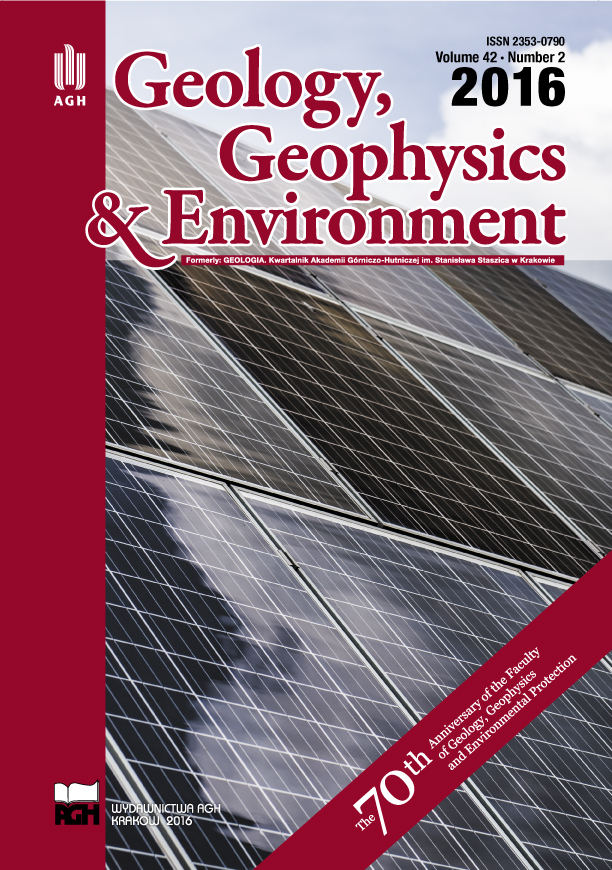Contrasting sediment and water chemistry indicates the extent of the hyporheic zone in a polluted river system
DOI:
https://doi.org/10.7494/geol.2016.42.2.151Keywords:
water, sediment, floodplain, Biała Przemsza RiverAbstract
The concentrations of zinc and cadmium were determined in the sediment cores sampled from the floodplain and the channel in the middle reach of the Biała Przemsza River valley (southern Poland). The results were compared to the river water and groundwater chemistry in order to reveal the average extent of the hyporheic flow. The loss of river waters through the river bed due to the natural migration modified by the drainage of the lead-zinc ore mine caused the strong pollution of the river bed sediments with heavy metals to the depth of almost three meters below the water table in the river. Moreover, the similar groundwater and river water chemistry at that depth suggests that the vertical extent of the hyporheic zone, which exceeds a depth of several meters below the channel, can be affected by the drainage of river waters by the lead-zinc mine. The lateral extent of the hyporheic flow, indicated by changes in groundwater chemistry and elevated heavy metal concentrations in the sediments, was of the order of dozen of meters. The investigation documents the large impact of the secondary in situ enrichment of sediments with heavy metals in the hyporheic zone.
Downloads
References
Aleksander-Kwaterczak U. & Ciszewski D., 2016. Pollutant dispersal in groundwater and sediments of gaining and losing river reaches affected by metal mining. Environmental Earth Science, 75, 95, DOI:10.1007/ s12665-015-4859-8.
Boulton A.J., Findlay S., Marmonier P., Stanley E.H. & Valet H.M., 1998. The functional significance of the hyporheic zone in streams and rivers. Annual Review of Ecological Systems, 29, 59–81.
Bourg A.C.M. & Bertin C., 1993. Biogeochemical processes during the infiltration of river water into an alluvial aquifer. Environmental Science and Technology, 27, 661–666.
Cardenas M.B., 2009. Stream-aquifer interactions and hyporheic exchange in gaining and losing sinuous streams. Water Resources Research 45, W06429, DOI:10.1029/2008WR007651.
Ciszewski D., 1998. Channel processes as a factor controlling accumulation of heavy metals in river bottom sediments: consequences for pollution monitoring (Upper Silesia, Poland). Environmental Geology , 36, 45–54.
Ciszewski D., 2003. Heavy metals in vertical profiles of the middle Odra River overbank sediments: evidence for pollution changes. Water, Air, & Soil Pollution , 143, 81–98.
Ciszewski D. & Bijata P., 2015. Hyporheic zone hydrochemistry of the mine polluted river. Journal of Geoscience and Environment Protection, 3, 47–52.
Chen X., Dong W., Ou G., Wang Z. & Liu C., 2013. Gaining and losing stream reaches have opposite hydraulic conductivity distribution patterns. Hydrology and Earth System Sciences, 17, 2569–2579.
Czop M. & Morman J., 2012. Antropogeniczne przeobrażenia reżimu hydrogeologicznego rzeki Sztoły w południowej części rejonu olkuskiego. Przegląd Górniczy, 68 (7), 126–132.
Danielopol D.L., Gibert J., Griebler C., Gunatilaka A., Hahn H.J., Messana G., Notenboom J. & Sket B., 2004. Incorporating ecological perspectives in European groundwater management policy. Environmental Conservation, 31, 3, 185–189.
Elliott A.H. & Brooks N.H., 1997. Transfer of nonsorbing solutes to a streambed with bed forms: Theory. Water Resources Research, 33, 1, 123–136.
Hancock P.J., Boulton A.J. & Humphreys W.F., 2005. Aquifers and hyporheic zones: towards an ecological understanding of groundwater. Hydrogeology Journal, 13, 1, 98–111.
Horowitz A.J., 1991. A Primer on sediment-trace element chemistry. Lewis Publishers, Chelsea, Michigan, 1–136.
Humphreys W.F., 2009. Hydrogeology and groundwater ecology: does each inform the other? Hydrogeology Journal, 17, 1, 5–21.
Kalbus E., Reinstorf F. & Schirmer M., 2006. Measuring methods for groundwater-surface water interactions: a review. Hydrology and Earth System Sciences, 10, 873–887.
Karwan D.L. & Saiers J.E., 2012. Hyporheic exchange and streambed filtration of suspended particles. Water Resoures Research, 48, W01519, DOI:10.1029/2011WR011173.
Kiel B.A. & Cardenas M.B., 2014. Lateral hyporheic exchange throughout the Mississippi River network. Nature Geoscience, 7, 413–417.
Kumar M., Ramanathan A. & Keshari A.K., 2009. Understanding the extent of interactions between groundwater and surface water through major ion chemistry and multivariate statistical techniques. Hydrological Processes, 23 (2), 297–310.
Motyka J. & Różkowski K., 2001. Wstępne wyniki badań ucieczek wody z Białej Przemszy na zawodnienie kopalni rud cynku i ołowiu „Pomorzany” (południowa Polska). [in:] XI. NHGK: hydrogeologie: multidisciplinární pojetí oboru: XI. národní hydrogeologický kongres: Ostrava, 19.– 21. Září 200: sborník. VSB-TU, Ostrava, 215–218.
Mugnai R., Messana G. & Di Lorenzo T., 2015. The hyporheic zone and its functions: revision and research status in Neotropical regions, Brazilian Journal of Biology, 75, 3, 524–534.
Ward A.S., 2016. The evolution and state of interdisciplinary hyporheic research. Wiley Interdisciplinary Reviews – Water, 3, 83–103.
Woessner W.W., 2000, Stream and f luvial plain ground water interactions: rescaling hydrogeologic thought. Ground Water, 38, 423–429.
Wroblicky G.J., Campana M.E., Valett H.M. & Dahm C.N., 1998. Seasonal variation in surface-subsurface water exchange and lateral hyporheic area of two stream-aquifer systems. Water Resources Research, 34, 317–328.
Downloads
Published
Issue
Section
License
Authors have full copyright and property rights to their work. Their copyrights to store the work, duplicate it in printing (as well as in the form of a digital CD recording), to make it available in the digital form, on the Internet and putting into circulation multiplied copies of the work worldwide are unlimited.
The content of the journal is freely available according to the Creative Commons License Attribution 4.0 International (CC BY 4.0)










